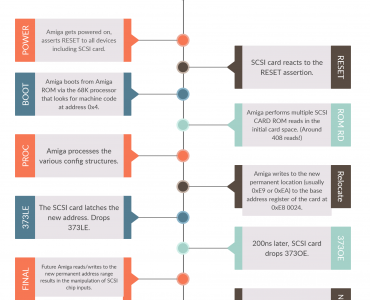I have uploaded a movie showing 30 seconds of input signal vs detected result. I checked this frame by frame and I didn’t find a single error. I still can’t figure out why I have output errors. Maybe you can...
new timing image
I think this is timing from like 97 or so, and this is pretty good. I’ve switched to 93 for the time being, because I’ve had the best results with that. This still shows accurate reading of this particular...
current results
Now that I have a portion of Marco’s old code implemented, I’ve run an output file from my SX through it. It’s one whole track from a capture of a DiskMonTools. It’s almost 14k long, which sounds...
of bit-shifted sectors
I’m beginning to think more and more that my software on the SX is just fine. Perhaps minus the idle routine mentioned in the last post. I have to do something there. However, without the idle routine, I was only...
funky idle routine
I’m making some progress. On a whim, I told my software to never go idle, to simply stream data constantly. I’ve never liked how I handle the idle state, and I currently lose whatever data thats in the shift...
Creating more test disks
From both Tim’s suggestions and from a reinforcement from Agans’ Debugging book, Chapter 6, “Divide and Conquer”, they suggest to “Inject Easy-to-Spot Patterns”. And of course, I knew...
Hardware and code diagram
I’ve thrown up a PDF that shows the basic hardware setup. It also shows the flow of my software, which is very simple. I didn’t put the clock details on there such as how often the clock rolls etc because...
review of timing details
I set up a couple more hardware flags on my software so I could see things like, edge detections vs rollover detections vs PC transmissions, etc. It all looks perfect to me. I took maybe a dozen different samples...
still no better
Well I’ve decided that my current approach just isn’t improving the situation. And despite help from a lot of people, I’m no better off than I was a few weeks ago. I happened to stumble upon...
Changes to the PC side
With more and more things pointing to the PC, I’ve decided to really reduce the amount of work the PC has to do in its receive loop. I looked at Marco’s because his was designed to run (albeit in dos/dos...
I’ve played around a considerable bit from yesterday. There’s something very strange about the speed the PC can react in certain circumstances, and I can’t quite nail it down. Now I haven’t...
PC might be the problem!
I think I’ve found at least one problem here. My PC is at least one problem. Even though I’ve done extensive tests with the PC in the past, including measuring a 9us total cycle time, it appears the PC must...
still hashing some ideas around
I’ve been getting lots of good ideas from the smart guys over at Parallax. They are throwing out a variety of methods and ways I can get this job done. I will say that I’m a little overwhelmed at the pure...
new design on SX software
Welp, I’m having trouble tweaking my existing SX code. If I modify the timing of the current code, I’m getting all garbage output — even adjusting small amounts to one side or the other, produces much...
more success reading valid data!
I created a disk with a textfile called AMIGA on it which contained thousands of “AMIGAAMIGAAMIGA” throughout the entire file. The idea here is that no matter which part I happen to read/decode, I can tell...
more SX to PC tests
Although I think I’ve long had this working good, I did some more tests just to verify. Latest numbers: Each cycle is about 15.8us, 2us per bit, 8 bits, this sounds fine. This does confirm, however, what I...
SX code
Ok so I’m using SX/B, which is BASIC for the SX. Even if you’ve never touched SX/B, it reads very easily, anyone who knows the PIC or other mcu should understand….. Here’s the logic behind the...
floppy.c’s mfm decoder
A couple days ago, whenever I got ahold of floppy.c, I wrote a quickie code stub that utilizes floppySectorMfmDecode from floppy.c of fellow (). Note you must use the mirrors to actually download anything…. This...







